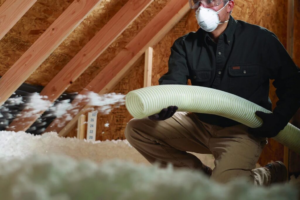How New Insulation Improves Home Energy Efficiency

Your home’s insulation helps with many things. For example, soundproofing and fire-proofing. Insulation also helps with your home’s temperature regulation. In other words, if you have old insulation, it may not be doing a great job of keeping your home warm. It may also be contributing to higher energy bills.
Most common insulation materials work by slowing conductive heat flow and convective heat flow. Radiant barriers and reflective insulation systems work by reducing radiant heat gain. To be effective, the reflective surface must be in contact with an air space.
Regardless of the mechanism, heat flows from warmer to cooler areas until there is no longer a temperature difference. In your home, this means that in winter, heat flows directly from all heated living spaces to adjacent unheated attics, garages, basements, and especially to the outdoors. Heat flow can also move indirectly through interior ceilings, walls, and floors–wherever there is a difference in temperature. During the cooling season, heat flows from the outdoors to the interior of a house.
To maintain comfort, the heat lost in the winter must be replaced by your heating system and the heat gained in the summer must be removed by your cooling system. Properly insulating your home will decrease this heat flow by providing an effective resistance to the flow of heat.
Spray Foam:
Spray foam is a modern insulation product that offers superior thermal performance. It can function in ways that older styles of insulation just can’t. This is because spray foam creates a monolithic seal that stops air and moisture infiltration in its tracks. As a result, when air and moisture can’t get into your home, it’s much easier to keep warm. You won’t need as much energy then to heat your home, and your energy bills will go down.
New Attic Insulation:
When you insulate your attic with new, high-performing insulation, you cover a lot of space in an easy-to-reach area. This makes insulating your attic more affordable than insulating other areas of your home. More importantly, insulating such a large area of your home will translate into bigger energy savings. It will keep that warm air inside and from rising out of the house! In addition, proper attic insulation and ventilation prevent moisture and frost from building up in the attic.
Insulation Materials:
Insulation materials run the gamut from bulky fiber materials such as fiberglass, rockwool, cellulose, and natural fibers to rigid foam boards to sleek foils. Bulky materials resist conductive heat flow in a building cavity. Rigid foam boards trap air or another gas in their cells to resist conductive heat flow. Highly reflective foils in radiant barriers and reflective insulation systems reflect radiant heat away from living spaces, making them particularly useful in cooling climates. Other less common materials such as cementitious and phenolic foams and perlite are also available.

